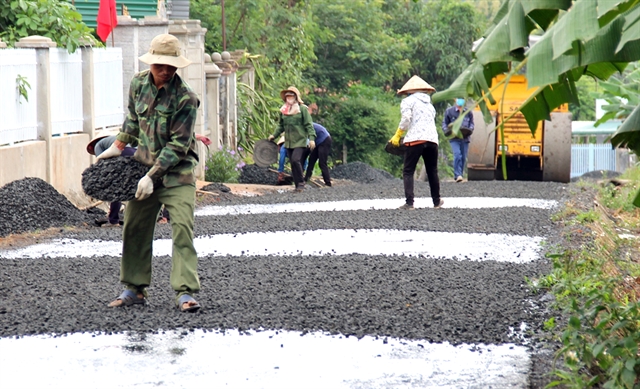 Society
Society


|
| Local residents help build a road in Đắk Lắk Province's Hòa Xuân Commune as part of the construction of new-style rural areas. — VNA/VNS Photo baodaklak.vn |
ĐẮK LẮK — Leaders of the Central Highlands province of Đắk Lắk have highlighted the need to spread good examples and practices in building new-style rural areas at a conference held on November 1 to review a decade of the work.
Deputy Secretary of the provincial Party Committee Phan Minh Tâm said the national target programme on building new-style rural areas has spread across the province, giving rural areas a facelift and improving living conditions.
Tâm asked agencies and authorities at all levels to research ways to duplicate good models, and pay more attention to local cultural characteristics in rural development.
He also called for research into agricultural restructuring, with a view to developing products for export.
Authorities should study weaknesses and problems such as uneven performance among localities, limited results in agricultural restructuring, and unsustainable quality of new-style rural areas, in order to design solutions, he said.
Participants at the conference shared experience in communication activities and resource mobilisation for building transport infrastructure, as well lessons in building production models to increase locals’ income. They also discussed difficulties and solutions in building new-style rural areas in ethnic minority and especially disadvantaged areas.
Chairman of the People’s Committee of Ea Sup District Nguyễn Văn Đông said his border district is among the poorest in Đắk Lắk, with large acreage but small population.
When building new-style rural areas, the district faced difficulties settling local residents in one place instead of living a nomadic life any more, as well as in defining key products, he said.
Ea Sup started with criteria deemed easier to achieve, or criteria with breakthrough meaning. After nearly 10 years, the district has achieved 112 out of the total 171 criteria in building new-style rural areas, he said.
Krông Bông District is in a similar situation.
Vice chairman of the district People’s Committee Y Thức Ê Ban said his district had a low starting point as a poor locality.
Krông Bông decided to create a breakthrough in transport to give the area a facelift and facilitate activities in other fields, he said.
The district encouraged local residents to contribute working days, land and money, he said.
The construction work was carried out in a transparent manner. At present, six of the district’s 13 communes have achieved the criterion on transport.
At provincial level, the administration and agencies have promulgated many documents to instruct the new rural area building campaign, with attention paid to raising public awareness about the work and educational campaigns.
The building of new-style rural areas has contributed significantly to improving rural infrastructure, developing cultural establishments and enhancing rural living standards.
During 2011-15, the household poverty rate in the province dropped by 14.8 per cent.
The rate reduced by 6.56 per cent in 2016-18. Average per-capita income is estimated at VNĐ29.4 million (US$1,270) in 2019.
The movement has engaged many people and changed the way of thinking of the majority of local residents.
During the past decade, people in Đắk Lắk contributed more than 1.2 million sq.m of land, more than VNĐ1.6 trillion ($68.7 million) and in excess of 2,100 working days to construct infrastructure.
Total capital for the new-style rural building programme in Đắk Lắk for 2011-2020 is estimated at more than VNĐ140.7 trillion ($6 billion).
As of June 2019, 43 communes in the province were recognised as new-style rural areas, three more than the target, and accounting for 28.3 per cent of total communes in the province.
One district-level administrative unit – Buôn Mat Thuột city- has also earned the title.
The province aims to have 61 communes recognised as new-style rural areas by the end of 2020. — VNS




